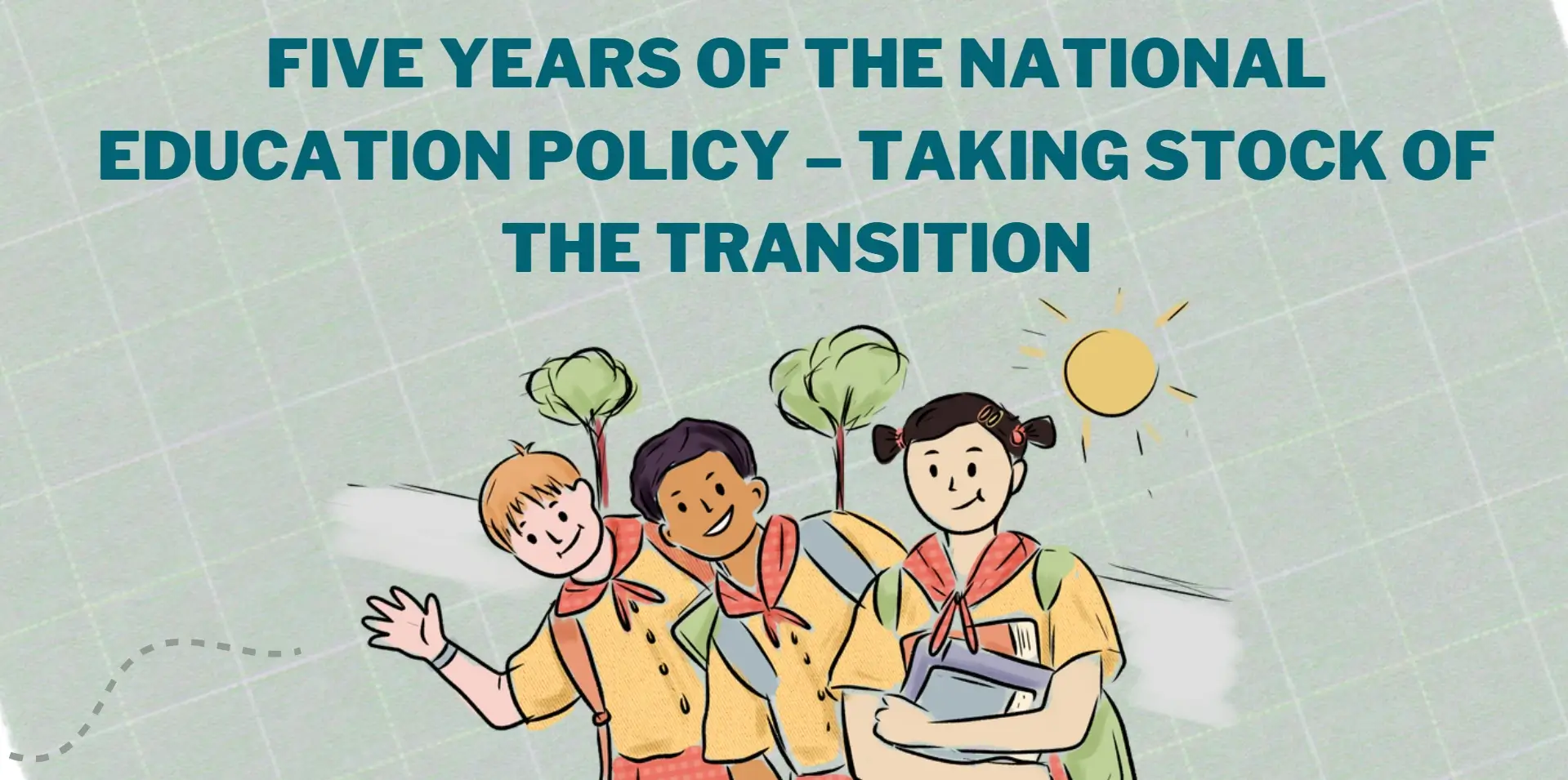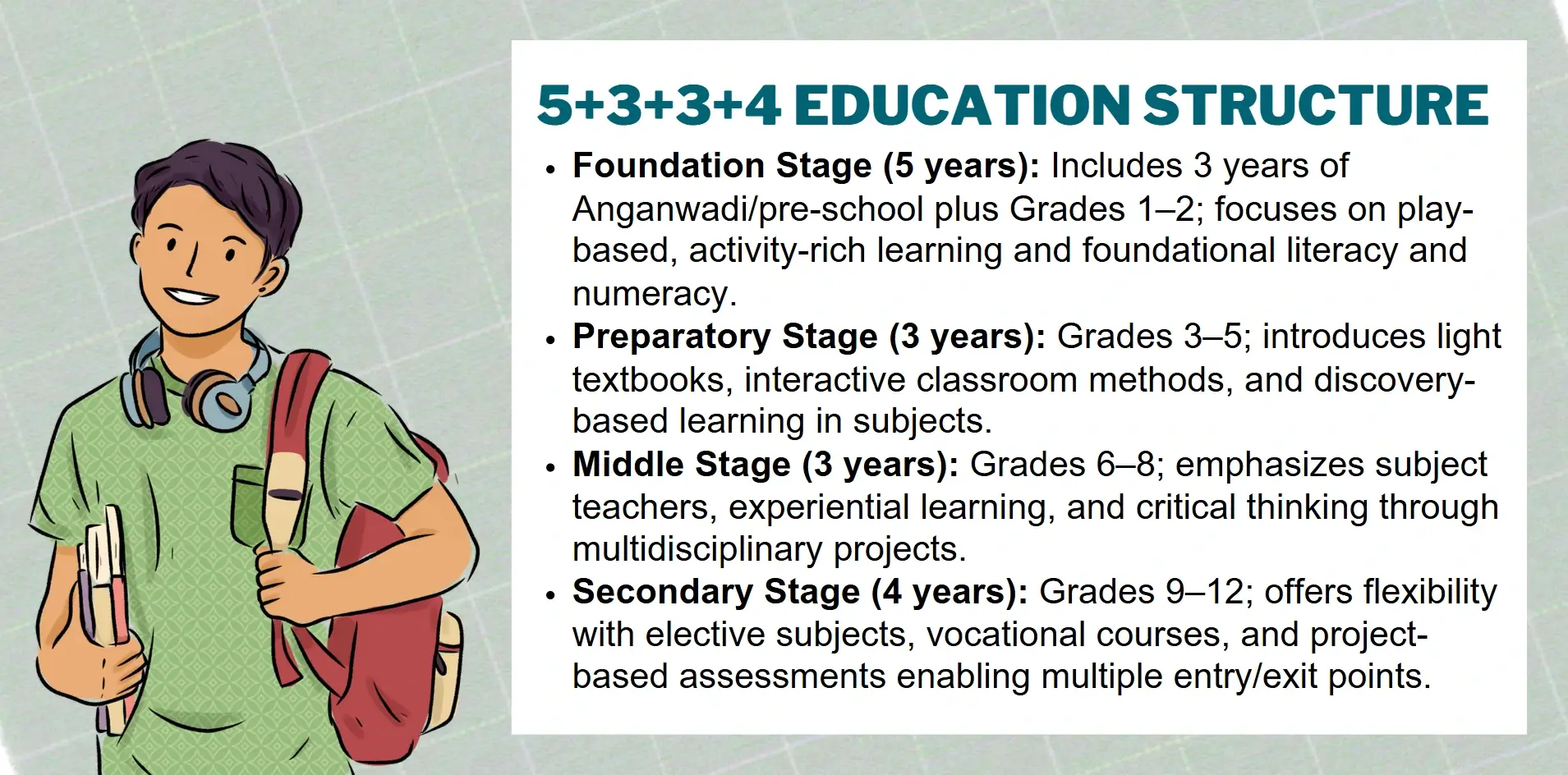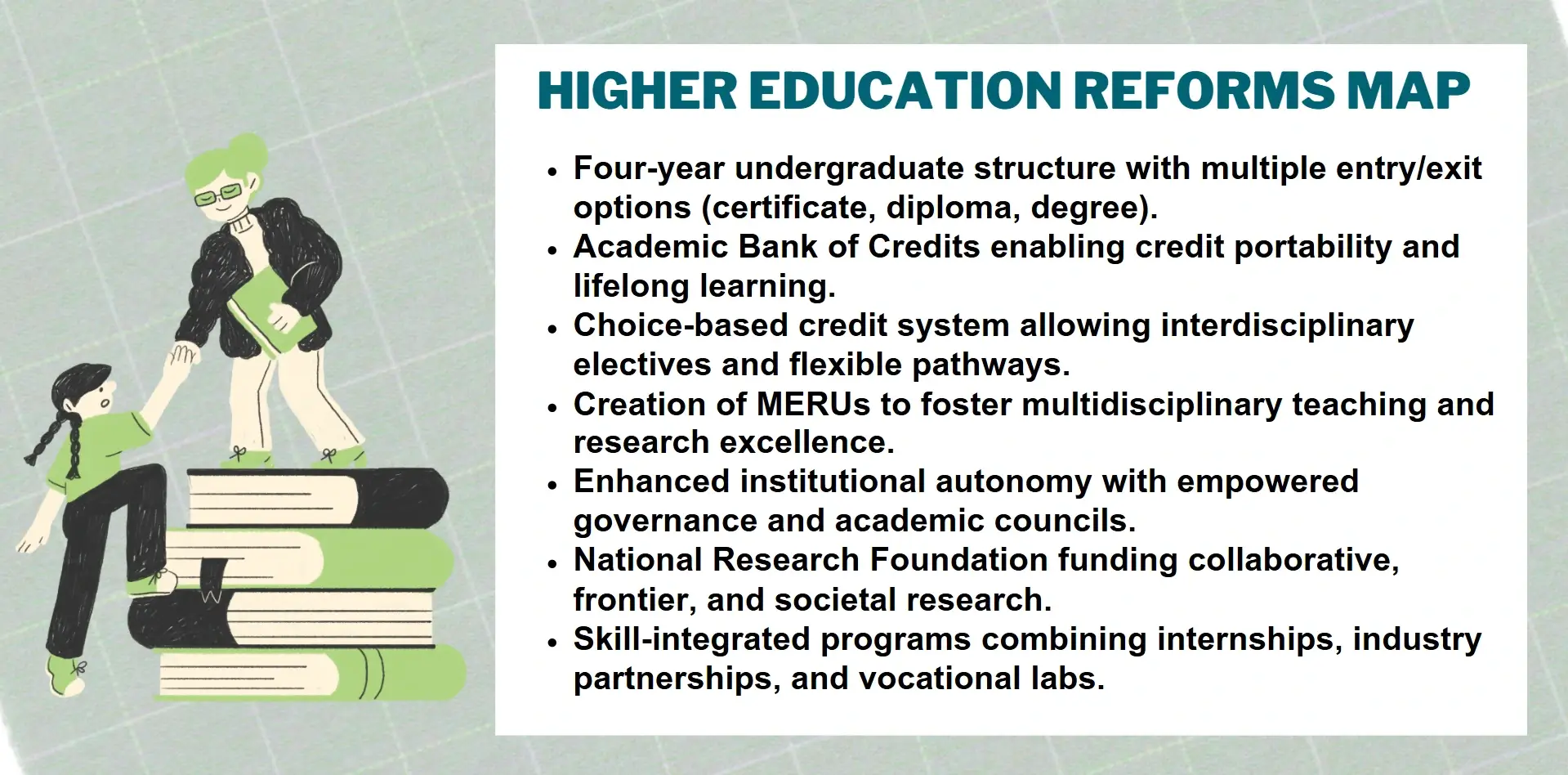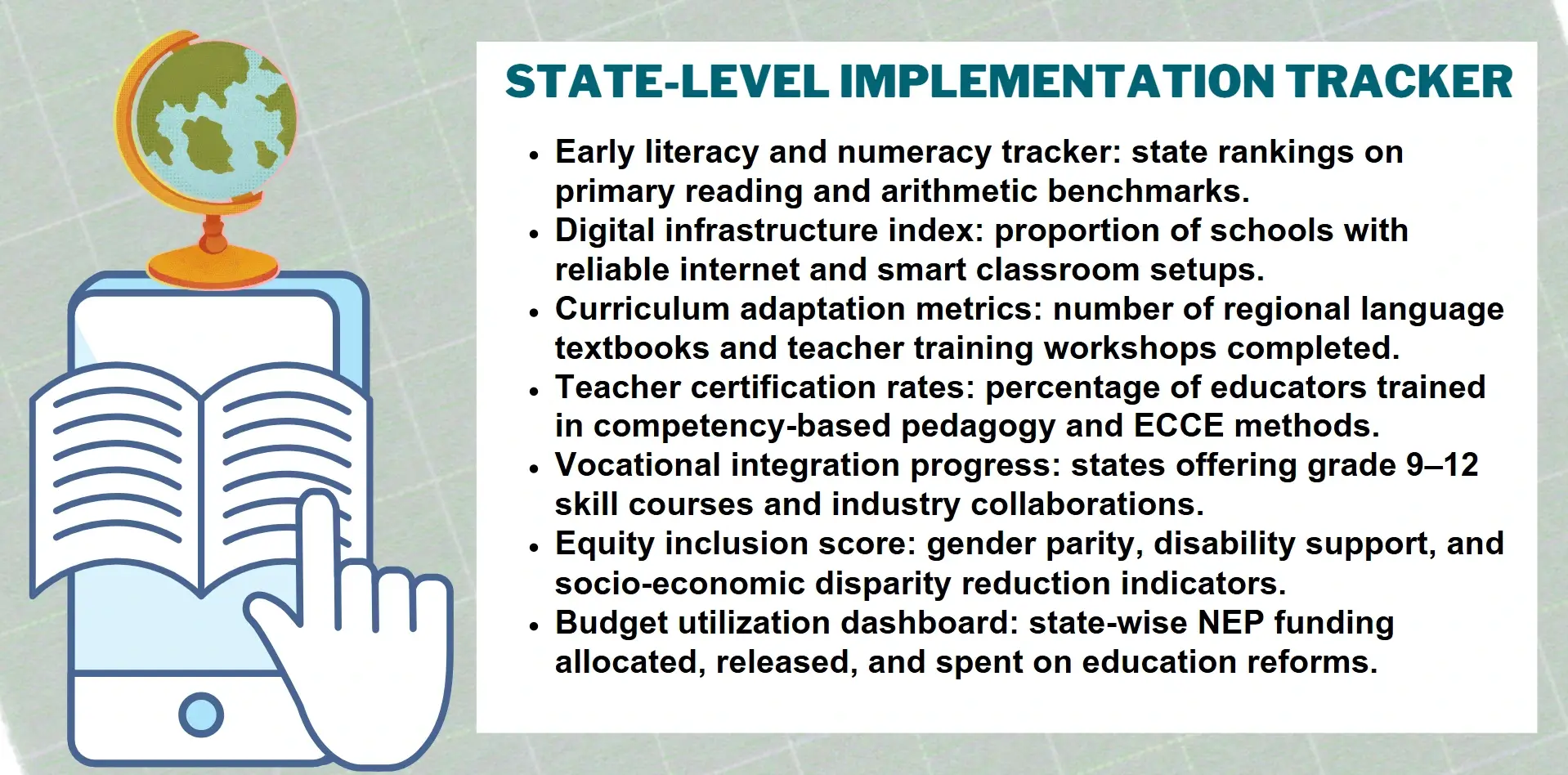The Article looks back at the developments of the NEP 2020 five years later- what has been done right, what has become stagnant and how delays in institutions and state-Centre tensions have come to prevail.

The National Education Policy (NEP) 2020represented a paradigm shift in redesigning the education system in India, targeting the reform of the existing system to make it more inclusive, multidisciplinary, and skill-based. With five years of its implementation, the policy, which includes lofty promises such as early childhood care reforms, overall curriculum redesign, digital inclusion, and multilingual education, has yet to deliver on its promises with mixed outcomes. Other major reforms, though, are still languishing in the morass of bureaucracy with some states implementing them much better than others, it is these reforms that are considered essential in enabling and empowering the vision that guides so much of what is set before these students today.This article gives a critical review of the policy to practice journey of NEP 2020 pointing out the effective interventions as well as the challenges that are on-going. It highlights concentrated disparities and revenue limitations between the Centre and states, and institutional stasis that have been impeding itself in a broad exchange. The article is also introspective of the use of public consultation process, organization of governance and the changing political rhetoric on education reform in India.
History and Vision of NEP 2020
The NEP 2020 is one of the first such initiatives of India to reform the learning systems and help in reconstituting and setting new academic agendas to a fast-changing socio-economic and technological environment.
Background
The long preceding National Policy of Education 2020which had been introduced in 1986 and revised in 1992 had long since lost track with the requirements of dynamic society in the 21stcentury. As the needs in innovation, globalization, and all-inclusive development emerged and intensified, the leaders of all fields demanded a paradigm shift. One of the biggest consultation processes in the history of Indian policy involved educators, students, researchers, policymakers as well as the civil society, and formed the basis of NEP 2020. Such participatory framework provided the policy with firm democratic background and ownership feeling, as it closed the dimensions between reality and hope on the ground.

Vision
The vision in the NEP 2020 is to have an education system whereby creativity, critical thinking and ethical anchoring are developed at all levels within an education system. The policy will look to universalise Early Childhood Care and Education (ECCE), to reform curricula in support of diminishing rote learning, instigating vocational and inter disciplinary studies and encouraging multilingualism. The central concern of democratizing education, which has always been there is the drive to regional, gender, caste and income equity in education.Such a vision is in close connection with Sustainable Development Goal number 4 (Quality Education), making India responsive to local challenges as well as actively contributing to global solutions.
Future-Oriented Goal
With its strong focus on flexibility, digital literacy, and institutional autonomy, NEP 2020 aims to raise the generation of citizens that will be able to develop in an ethical and globalized way. This policy aligns knowledge to employability, creativity to citizenship, and technology to the tradition-raising the bar past the traditional parameters of measuring their success to design inclusive and future-ready education ecosystems.
Mechanisms of Implementation and Reforms
The implementation of NEP 2020 in school education is gearing itself through institutional processes, redesigning of curriculum, and changes in pedagogy, a transformation of classroom processes in favour of an inclusive and enjoyable (joyful) and skill-based education.
Institutional Framework
To materialize its enormous goals, NEP 2020 is assisted by national organizations such as NCERT, SCERTs, and recently established PARAKH (Performance Assessment, Review, and Analysis of Knowledge as Holistic Development). To implement the plan, a phased roadmap was initiated by the Ministry of Education, with the priority given to Foundational Literacy and Numeracy (FLN),early childhood care, and teacher development. The Centre-state level coordination can be achieved by using such platforms as Vidya Samiksha Kendra,which can ensure real and minute-to-minute tracking of the data and provide academic assistance. Alongside the given frameworks, dis-homogeneity in adaptation within the state and lack of capacity serve as some of the key constraints to cohesive reform.
Curriculum Redesign
One of the main changes to be considered under NEP is the change of curriculum towards a more flexible and competency-based curriculum. The National Curriculum Framework (NCF) on School Education is concerned with experiential learning, interdisciplinary achievements, and less use of rote memory. The 5+3+3+4 curricula structure contributes to age-appropriate pedagogicalteaching and differentiation of learning paths. Subjects in the areas of vocational studies, coding, and environmental education have now been integrated into the core curricula and are seen as an attempt to fill the holes between academic and in-life skills. There is a focus on conceptual clarity and relevance as a foundation before volume and repetition on the one hand and relevance on the other, represented by this reorientation.
Pedagogical Transformation
The pedagogy of classrooms is under re-conceptualization to promote inquiry-based, student-focused classrooms. The teachers are strongly advised to embrace multilingualism in their teaching strategies, the localization of contexts, and the active provision of reflective discourse. Foundational classes ECCE reforms guarantee that classes (pre-primary to Grade 2) are centred on interplay, stories and engage with pupils. Resource centres and modules on teacher training facilitate inclusive education of disabled children and children of marginalized communities. Socio-emotional learning and ethical ways of thinking are primary competencies promoted by the policy, and the digital tools increase access and personalization of learning materials.
Monitoring & Evaluation
PARAKH is going to provide a centralized system to evaluate the learning outcome beyond high-stakes testing. Formative assessment and diagnostic feedback are concentrated on to determine classroom activities. States are modifying the Angeles of report cards by emphasizing on skills, attitudes and improvement of different levels. Although implementation has been progressed in certain districts it cannot be successful long-term with support only in funding and teacher empowerment and policy stability.
Higher Education Reforms in Classroom and Campus
By promoting openness, multidisciplinary education, and institutional independence, NEP 2020 transforms India to a higher educationsector that is very flexible, multidisciplinary, and more institution-focused across campuses.

Academic Flexibility
The importance of economic development as the core vision of NEP regarding higher education consists in moving the structure of the curriculum to the more flexible pattern. New four-year undergraduate structure where the student has the option to enter and exit at different stages gives students discretional power to learn at their own pace. Credit portability and lifelong learning are rolled out with credit-based systems and the Academic Bank of Credits (ABC support). Such modularity breaks the fixed disciplinary boundaries, to create harmony among science, humanities, technology and the arts, which is required to develop holistic thinkers and problem-solvers.
Campus Innovations
It is also encouraging universities and colleges to transform themselves into autonomous institutions that have better governance structures. The establishment of Multidisciplinary Education and Research Universities (MERUs) and the enhancement of the research ecologies are expected to increase the academic standards and competitiveness on an international scale. Advanced infrastructures supporting innovation in STEM, cultural interaction and online learning are part of the campuses and reforms are supporting collaboration between academic institutions, the industry and the civil society. The National Research Foundation (NRF) holds research capacity, particularly on socially affecting and frontier technologies.
Pedagogical Reform
The redesigning of classroom scenarios is in motion to support critical pedagogy, inquiry-based learning and outcome-based teaching. The priority is given to faculty development based on constant training and international exchange programs. The more institutions introduce multidisciplinary electives, internships, and skillslabs with the interests of the nation and international benchmarks, the higher they will be rewarded. Social relevance and diversity among the learners is created through these approaches to the curricula building through inclusion of the Indian knowledge systems and values, ethics and gender sensitivity.
Impact Assessment &Early Outcomes
With a 5-year post-implementation mark, NEP 2020 has revealed encouraging tendencies concerning the core literacy, online education, and curriculum transformation as well but issues related to scale, equity, and conformity to institutions have become urgent.
Foundational Gains
Some states have even recorded positive results in the early-grade reading and numeracy levels. Such states as Uttar Pradesh and Tamil Nadu adopted localized content and training plans, and this aspect helped to achieve improved learning among primary schools. The anganwadicenters are also becoming a part of official ECCE, which facilitates a better transition to Grade 1. Nevertheless, lack of equality in rural infrastructure and teacher capacity has persisted to influence uniformity across districts.
Digital Inclusion Teacher Empowerment
After the pandemic, there was a marked improvement in NEP with its concerns about digital learning. Innovations such as DIKSHA and PM eVIDYA have opened up multilingual multi-grade resources to students and teachers. New pedagogical techniques have been learned by educators through the use of professional development modules, which are accessed both online and offline. However, there is still a reality of digital divides that occurs in distant and disadvantaged societies, and this presents difficulties to the fair distribution of technologically-based learning.
Curricular Reform Multilingual Learning
The National curriculum framework has already started to transform classroom practices in competency based interdisciplinary learning. States are developing textbooks in the use of regional languages, stories, and content which is relevant to the context. The improvement of this reform is in line with the multilingual vision of NEP and improves the engagement of the students. Multiple pilot projects on modular learning and vocational integration have been early adopters in the urban agglomerations, and policy intervention is needed in the rural scalability.
Systemic feedback and Assessment Realignment
The framework of PARAKH will alternatively substitute the high-stakes assessments and culture with diagnosis and formative assessments. Now, the content of the reworked report cards focuses on social-emotional development, collaboration with peers, and progressing in each subject. Such preliminary changes are reassuring the reform of classroom, although the long-lasting success will be predetermined by the greater matching of boards and institutions.
Recommendations and Way ahead
As NEP 2020 enters its fifth year, strategic modifications and continued investments and substantial federal collaboration will be critical as it seeks to accomplish its transformative potential in the heterogeneous education sphere in India.
Convergence of Institutional Disparages and Centre-State Collaboration
There must be a more nimble and cooperative form of governance that standardizes NEP objectives among states. Context-responsive execution is possible through regular review mechanisms, decentralised planning and innovation hubs at state-level. By bringing in convergence of the ministry of education, skill development, and social welfare on common platforms, the delivery of policy initiatives would be simplified, and silos would be less in the administration.

Increasing customization of curriculum and multilingual incorporation
Curriculum reforms should not only be focused on textbook but also it should serve the good word in circulating local systems of knowledge, local language, as well as local connections. Customization of content through geographic and socio-cultural contexts (particularly tribal and remote) can enhance the effectiveness of learning knowledge and maintenance. The tools of education technology must not supplant but instead support the diversity of languages so that the population can have inclusive access to language in the India, multilingual context.
Resource and Ecosystems of Teacher Training
Strength in capacity-building is vital in terms of investing in teachers. Lifelong learning, mentorship networks, and blended learning models will enable teachers to be ready to adapt within the pedagogical change. They should increase their resource centres that provide curriculum support, digital tools, and partnerships in communities that cover the value of equity and assist the underserved regions.
Outcome monitoring and Investment in Equity
Policy refinement is advisable using a data-informed method. In addition to PARAKH, India requires long-term instruments to determine equity gaps,social-emotional achievements, and regional inequalities. NEP will also have dedicated financing to ensure gender-sensitive education, inclusion of special needs, and rural areas are digitalized will support the equity vision of NEP. The scale and mobilization of innovation can be achieved through public-private efforts.
International Standardization and Localization
India needs to compare the results of NEP with international standards without losing the richness of its culture. A further way to increase impact is to join international education exchanges and leverage best practices into Indian contexts. In the end, NEP will only work as long as policy intent is combined with long-term, inclusive, and adaptive policymaking.
Conclusion
After five years of its implementation, NEP 2020 has become as visionary as a process of work. It holistic vision, which is to democratize the learning process and bridge the bureaucratic gaps as well as to align the educational system of India with the international standards, has led to the paradigm shifts at the individual level, at the university levels, as well as at the policy levels. Curriculum flexibility, digital learning, and equity-oriented program reforms demonstrate some promising trends early on but still have major impediments related to federal coordination capacity and teacher ability and accessibility in rural areas.NEP needs to progress beyond structural change to continuous practice where innovation, accountability and inclusive collaboration are characteristic features. Engaged in participatory governance and investing intelligently, India can transform education into a policy objective and turn it into a reality that learners can all enjoy. The next years will not only help to revise the blueprint that NEP provides, but to create a new society that is youth-friendly and aimed at the future and development through lifelong learning and responsible evolution.